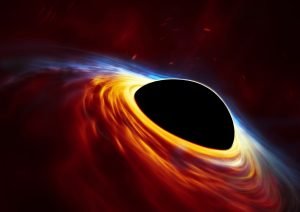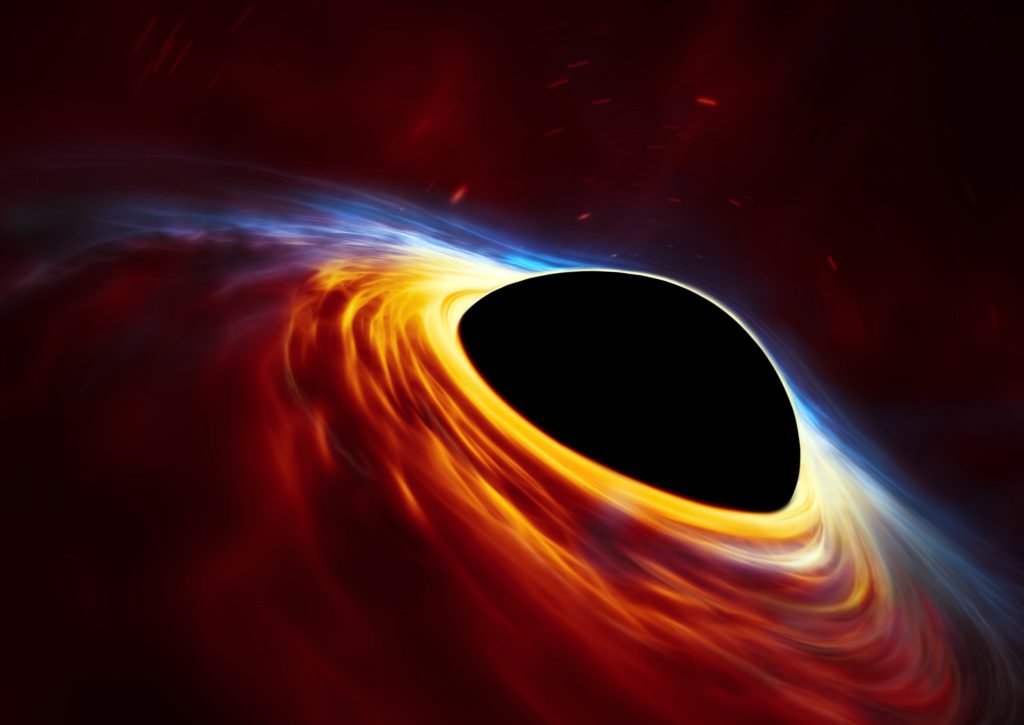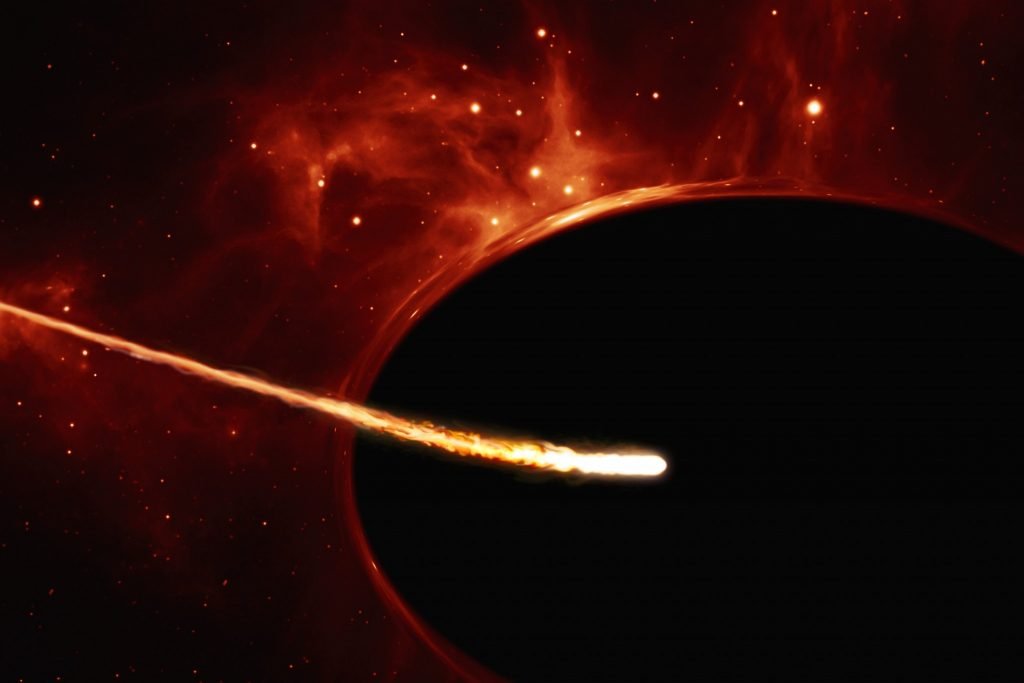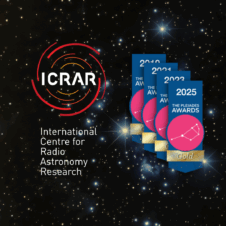An extraordinarily brilliant point of light seen in a distant galaxy, and dubbed ASASSN-15lh, was thought to be the brightest supernova ever seen. But new observations from several observatories, including ESO, have now cast doubt on this classification. Instead, a group of astronomers propose that the source was an even more extreme and very rare event — a rapidly spinning black hole ripping apart a passing star that came too close.

This artist’s impression depicts a rapidly spinning supermassive black hole surrounded by an accretion disc. This thin disc of rotating material consists of the leftovers of a Sun-like star which was ripped apart by the tidal forces of the black hole. Shocks in the colliding debris as well as heat generated in accretion led to a burst of light, resembling a supernova explosion. Credit: ESO, ESA/Hubble, M. Kornmesser
In 2015, the All Sky Automated Survey for SuperNovae (ASAS-SN) detected an event, named ASASSN-15lh, that was recorded as the brightest supernova ever — and categorised as a superluminous supernova, the explosion of an extremely massive star at the end of its life. It was twice as bright as the previous record holder, and at its peak was 20 times brighter than the total light output of the entire Milky Way.
An international team, led by Giorgos Leloudas at the Weizmann Institute of Science, Israel, and the Dark Cosmology Centre, Denmark, has now made additional observations of the distant galaxy, about 4 billion light-years from Earth, where the explosion took place and they have proposed a new explanation for this extraordinary event.
“We observed the source for 10 months following the event and have concluded that the explanation is unlikely to lie with an extraordinarily bright supernova. Our results indicate that the event was probably caused by a rapidly spinning supermassive black hole as it destroyed a low-mass star,” explains Leloudas.
In this scenario, the extreme gravitational forces of a supermassive black hole, located in the centre of the host galaxy, ripped apart a Sun-like star that wandered too close — a so-called tidal disruption event, something so far only observed about 10 times. In the process, the star was “spaghettified” and shocks in the colliding debris as well as heat generated in accretion led to a burst of light. This gave the event the appearance of a very bright supernova explosion, even though the star would not have become a supernova on its own as it did not have enough mass.
The team based their new conclusions on observations from a selection of telescopes, both on the ground and in space. Among them was the Very Large Telescope at ESO’s Paranal Observatory, the New Technology Telescope at ESO’s La Silla Observatory and the NASA/ESA Hubble Space Telescope. The observations with the NTT were made as part of the Public ESO Spectroscopic Survey of Transient Objects (PESSTO).
“There are several independent aspects to the observations that suggest that this event was indeed a tidal disruption and not a superluminous supernova,” explains coauthor Morgan Fraser from the University of Cambridge, UK (now at University College Dublin, Ireland).
In particular, the data revealed that the event went through three distinct phases over the 10 months of follow-up observations. These data overall more closely resemble what is expected for a tidal disruption than a superluminous supernova. An observed re-brightening in ultraviolet light as well as a temperature increase further reduce the likelihood of a supernova event. Furthermore, the location of the event — a red, massive and passive galaxy — is not the usual home for a superluminous supernova explosion, which normally occur in blue, star-forming dwarf galaxies.
Although the team say a supernova source is therefore very unlikely, they accept that a classical tidal disruption event would not be an adequate explanation for the event either. Team member Nicholas Stone from Columbia University, USA, elaborates: “The tidal disruption event we propose cannot be explained with a non-spinning supermassive black hole. We argue that ASASSN-15lh was a tidal disruption event arising from a very particular kind of black hole.”
The mass of the host galaxy implies that the supermassive black hole at its centre has a mass of at least 100 million times that of the Sun. A black hole of this mass would normally be unable to disrupt stars outside of its event horizon — the boundary within which nothing is able to escape its gravitational pull. However, if the black hole is a particular kind that happens to be rapidly spinning — a so-called Kerr black hole — the situation changes and this limit no longer applies.
“Even with all the collected data we cannot say with 100% certainty that the ASASSN-15lh event was a tidal disruption event,” concludes Leloudas. “But it is by far the most likely explanation.”
PUBLICATION DETAILS
This research was presented in a paper entitled “The Superluminous Transient ASASSN-15lh as a Tidal Disruption Event from a Kerr Black Hole”, by G. Leloudas et al. to appear in the new Nature Astronomy magazine.
Click here for the research paper
MORE INFORMATION
The European Southern Observatory
The European Southern Observatory (ESO) operates three unique world-class observing sites in Chile: La Silla, Paranal and Chajnantor. At Paranal, ESO operates the Very Large Telescope, the world’s most advanced visible-light astronomical observatory and two survey telescopes. VISTA works in the infrared and is the world’s largest survey telescope and the VLT Survey Telescope is the largest telescope designed to exclusively survey the skies in visible light.
As well as the data from ESO’s Very Large Telescope, the New Technology Telescope and the NASA/ESA Hubble Space Telescope the team used observations from NASA’s Swift telescope, the Las Cumbres Observatory Global Telescope (LCOGT), the Australia Telescope Compact Array, ESA’s XMM-Newton, the Wide-Field Spectrograph (WiFeS) and the Magellan Telescope.
CONTACT INFORMATION
Dr James Miller-Jones—Curtin University, ICRAR (Western Australia)
E: james.miller-jones@icrar.org
M: +61 488 484 825
Note: Dr Miller-Jones is currently overseas in the UK. Please contact him via email at any time or via his mobile number during UK business hours.
Dr Giorgos Leloudas—Niels Bohr Institute, University of Copenhagen (Denmark)
E: giorgos@dark-cosmology.dk
Tel: +972 89346511
Richard Hook—Media Contact, European Southern Observatory (Germany)
E: rhook@eso.org
M: +49 151 1537 3591
Pete Wheeler—Media Contact, ICRAR
E: pete.wheeler@icrar.org
M: +61 423 982 018
MULTIMEDIA
Animation: Spinning supermassive black hole rips a star apart (artist’s impression)
This animation shows how the ASASSN-15lh most likely happened. A Sun-like star gets into the area of influence of a rapidly spinning supermassive black hole in the centre of a distant galaxy. While its orbit gets constantly closer to the black hole the star gets “spaghettified”, creating an accretion disc around the supermassive black hole. When it finally gets ripped apart close to the event horizon it creates a bright flash, similar to a superluminous supernova. Credit: ESO, ESA/Hubble, M. Kornmesser
Image: A supermassive black hole with torn-apart star

This artist’s impression depicts a rapidly spinning supermassive black hole surrounded by an accretion disc. This thin disc of rotating material consists of the leftovers of a Sun-like star which was ripped apart by the tidal forces of the black hole. Shocks in the colliding debris as well as heat generated in accretion led to a burst of light, resembling a supernova explosion. Credit: ESO, ESA/Hubble, M. Kornmesser
Image: A close-up of star near a supermassive black hole

This artist’s impression depicts a Sun-like star close to a rapidly spinning supermassive black hole, with a mass of about 100 million times the mass of the Sun, in the centre of a distant galaxy. Its large mass bends the light from stars and gas behind it. Despite being way more massive than the star, the supermassive black hole has an event horizon which is only 200 times larger than the size of the star. Its fast rotation has changed its shape into an oblate sphere. The gravitational pull of the supermassive black hole rips the the star apart in a tidal disruption event.In the process, the star was “spaghettified” and shocks in the colliding debris as well as heat generated in accretion led to a burst of light. Credit: ESO, ESA/Hubble, M. Kornmesser

